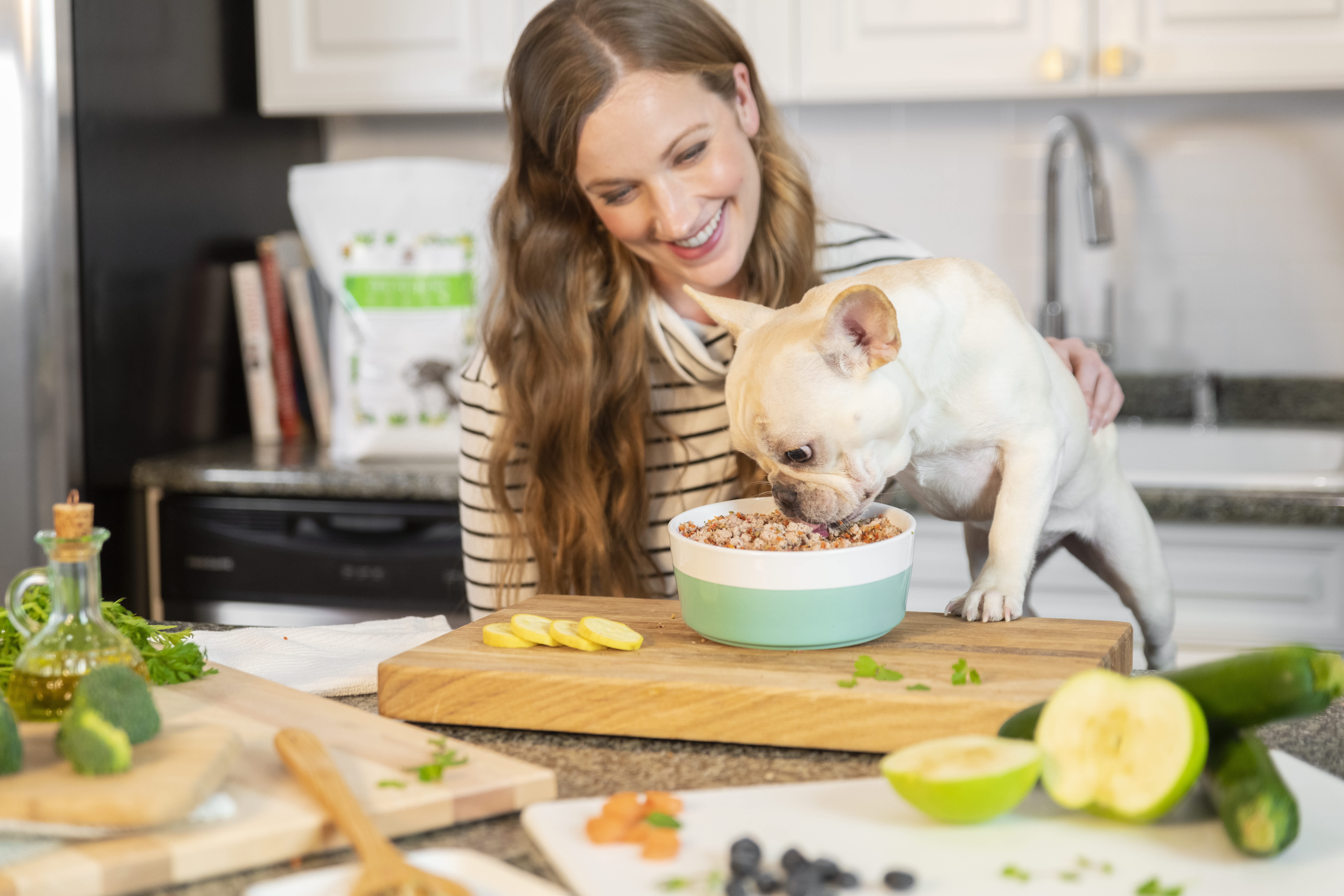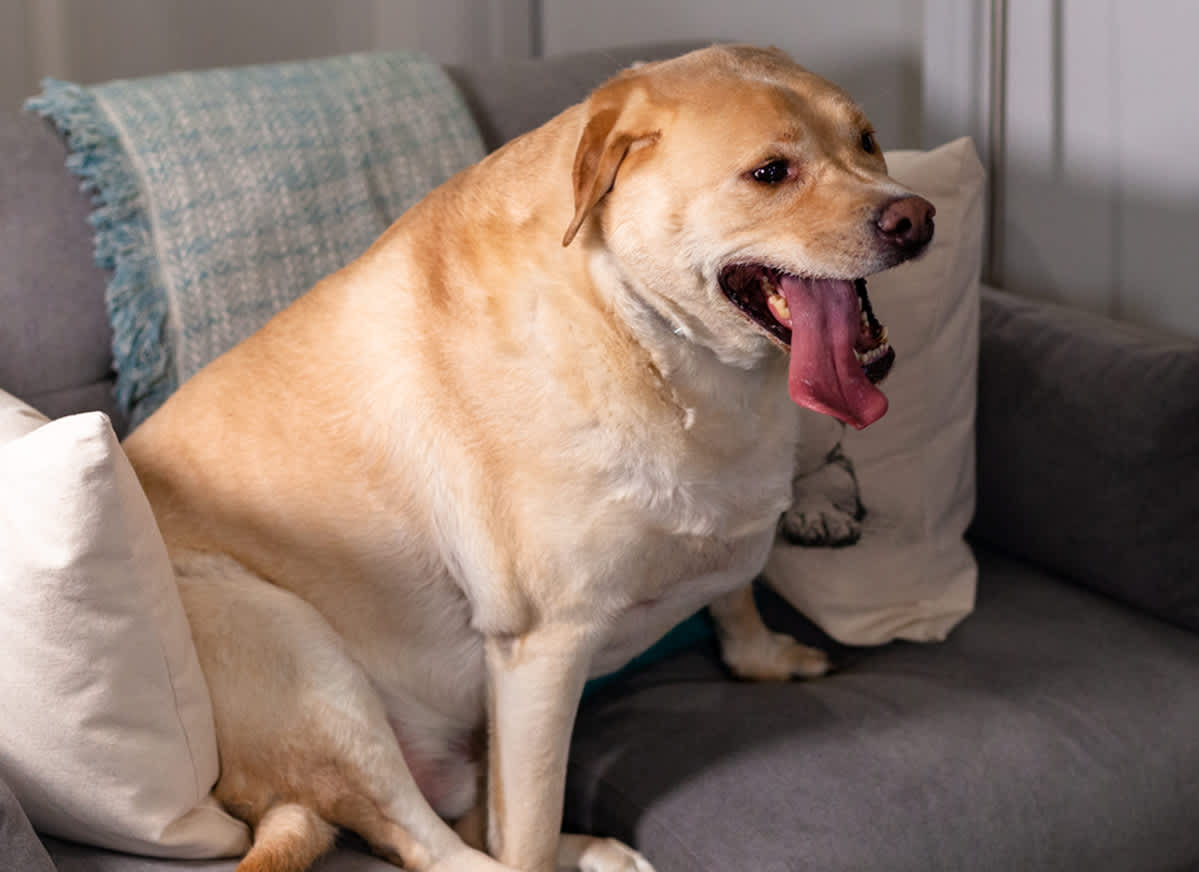The Pet Obesity Prevalence study showed that in 2022 59% of dogs were overweight or obese. What’s worse is that pet parents didn’t even realize it—36% of dog parents thought their dogs were at a normal weight when they were actually overweight or obese.
Being overweight is extremely dangerous for dogs and can even shorten their lives. Fortunately, your companion can lose weight; experts agree the best way is through a high-quality diet.
Keep reading to learn how to tell if your dog is overweight, why they gained weight in the first place, and how to help your dog lose weight.
Dangers of an Overweight Dog
You probably already know that being overweight is bad for your dog, but how bad is it? For one thing, it could take a couple of years off their lifespan.
Being overweight relates to various health conditions like the following:
ACL tears: Did you know excess weight is a significant factor in causing ACL tears?
Arthritis (osteoporosis): The pressure from the extra weight can cause joint cartilage to break down, leading to joint pain in various parts of the body.
Breathing problems: Fat can change your dog’s breathing pattern when they’re obese; you may notice more panting.
Heart conditions: Because the heart must pump harder, overweight dogs can develop heart problems.
High blood pressure: Along with heart conditions, the pressure within your dog’s blood vessels can be consistently too high.
Skin issues: Extra skin folds can trap sweat and dead skin, causing irritation and bacterial infections.
What Causes Weight Gain in Dogs?
Your companion can gain weight for various reasons.
Age
As your dog ages, its body systems and metabolism slow down. Once your dog reaches middle age and older, they’re more likely to gain weight even if their diet hasn’t changed.
Diet
Just as with your diet, if all you eat is junk food, you’ll gain weight (and not feel great). When you consistently feed dogs a processed kibble diet, they’re unable to digest properly, so they store these empty calories as fat. Kibble contains a high amount of poor-quality, highly-processed starches and fillers. Low quality ingredients can also be found in “grain-free” kibble and commercial dog treats.
Lack of Exercise
Both humans and dogs need physical exercise to maintain their health. When dogs don’t get enough exercise, they don’t burn enough calories to maintain weight.
Overeating
Whether you can’t resist those begging eyes or let your dog graze throughout the day, having access to too much food is the quickest way for a dog to gain weight.
What’s the Difference Between Overweight and Obese Dogs?
You might wonder, “Is my dog overweight or obese?” The difference between the two is a slight change in percentage. Overweight dogs are 10-30% over their ideal body weight, while obese dogs are 30% and up.
That can be hard to understand, so another way to learn how to tell if your dog is overweight or obese entails feeling your dog’s body and grading them using the Body Condition Score (which you’ll learn more about below).
If a dog is overweight, it will be hard to feel its ribs, and when looking at them from the side, you’ll notice its body is rounder than before. If a dog is obese, you won’t be able to feel its ribs and will probably see its stomach hanging out when looking at your dog from the side.
How Do You Tell If Your Dog Is at a Healthy Weight?
Of course, weighing your dog will give you the best idea of how much your dog weighs, but not everyone has access to a proper scale. Human scales don’t work well for dogs. Instead, people use Body Condition Score to track weight.
Body Condition Score (BCS)

Using Body Condition Scoring, pet parents can easily monitor their dog’s weight and see how close their dog may be to becoming overweight. This method uses how a dog’s body looks and feels to connect it to a scale ranging from one to nine.
Here’s what the numbers mean:
- 1-2: Very thin
- 3-4: Thin
- 5: Ideal
- 6-7: Overweight
- 8-9: Obese
How to Measure Your Dog’s Body
When using BCS, look and feel around your dog’s body to compare what you feel to the numbers of the BCS. The three areas you focus on are the ribs, waist, and hips.
For the ribs, an ideal score means easily feeling the ribs as you run your fingers along your dog’s body, though the ribs aren’t visible.
If you can visibly see the ribs, meaning they’re sticking out, then your dog is on the thinner side. If the ribs are difficult to feel and you mostly feel something squishy (fat), then they’re on the overweight side.
With the waist, much can be measured by what you see. Looking at your dog’s body from above, you should see an hourglass shape. From the side, there should be a defined waist with an “abdominal tuck” (no sagging stomach). If your dog has both these features, they are ideal size.
If your dog is too thin, you’ll notice more bones sticking out when looking at them from above and the side. When a dog is overweight, there’s a less defined waist and more of a sagging stomach.
If your dog is extra fluffy, you may have to feel for the waist and abdominal tuck.
You can easily feel a healthy dog’s hips with a little fat protecting them, but they won’t be visible. When they’re too thin, the hip bones will stick out, and you won’t feel them at all when they’re overweight.
Tips for How to Help Dogs Lose Weight
If you realize your dog is overweight, don’t panic. There are plenty of ways you can help them lose weight and create a weight loss plan that works for them.
First, you must determine your dog’s ideal weight because a too-thin dog can be just as unhealthy as an overweight dog.
A Better Diet and Proper Feeding Schedule
Regarding weight loss, it’s critical to choose your dog’s food based on nutrients, not just calories. Natural whole food works with a dog’s natural digestive system, enabling them to absorb and utilize vital nutrition.
Knowing how to help your dog lose weight means creating meals with good protein, vitamin, and mineral sources. They’ll feel better and fuller compared to the empty calories of kibble.
Notice how we said creating meals. If you’re trying to get your dog to lose weight, it’s time to get them on a feeding schedule—no more grazing!
But what about training or when you can’t take the begging anymore? You can still give them treats—just replace fatty treats with dog-friendly vegetables like carrots and celery. Veggies are healthier, take longer to eat, and will help clean their teeth.
Dr. Harvey’s Healthy Weight and Paradigm are great foods for dogs that need to lose weight.
Exercise
An easy way to ease your dog into exercising more is to take longer walks—even a 30-minute walk can make a huge difference. As your dog gets fitter, keep increasing your walking time.
Just take it slow at first. You don’t want to hurt your dog as it builds back its health.
You can also go to dog parks, try swimming, or use dog obstacle courses. If they aren’t ready for a lot of exercise, you can start moving their food bowl around the house so they have to get up and find it—that way, they at least begin to move a little.
Weight Loss Doesn’t Have to Be Hard for You or Your Dog
If you didn’t realize your dog was overweight, you’re not alone. With good planning, a proper diet, and more exercise, your dog will likely begin to lose weight. If you’re worried about finding the right ingredients for delicious homemade meals for your dog, make sure to check out our selection of healthy dog food.




